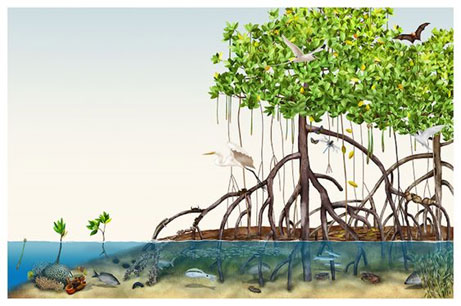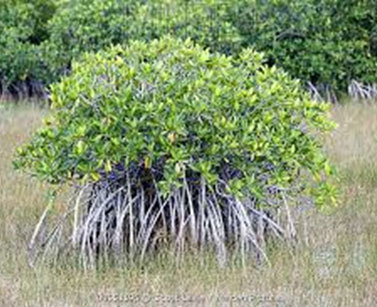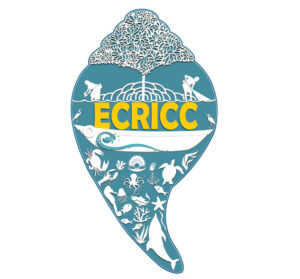Types of Mangroves

Red mangrove (Rhizophora mangle), are remarkably known by their above ground “prop roots” that are tangled, reddish, ariel roots originating from the trunks and branches. These are also referred as “walking trees” because their continuously growing prop roots make them look like they are walking on water.
These prop roots help transport air to their waterlogged below ground roots, and as well trap the sediment moving with the tide, gradually building up soil around the plant. These grow at sea level, right along the shore that can survive in 60-65ppt salinity. In the tropics, they can grow to more than 80 feets (24 meters) in height. Its small flower blossoms are pollinated by wind and the seeds sprout roots while still on the tree. After a few months, the seed drops to the ground and can immediately begin to grow. Seeds that drop into the water, float along until they reach a suitable area to put down their roots. These submerged roots provide a nursery habitat to fish, a number of mammals, birds, and reptiles.

The Black Mangrove (Avicennia germinans) are identified by numerous finger-like projections or the poking out roots, called pneumatophores, that protrude from the sediment around the tree’s trunk. As the trunk and heartwood is blackish in color, hence the name.
These are found at elevations slightly higher upland from red mangrove, in the upper intertidal zone of protected coastal bays, estuaries, salt ponds, salt marshes and protected coastlines. The tidal change exposes the roots to air, allowing the roots to breathe even when they are submerged. These can grow to 30-50 ft (9-15.3 m) tall.
These have white flowers in spring and summer, followed by green tear-drop shaped seeds, encased in a fruit. These seeds germinate while on the tree and produce a seedling with well developed roots and leaves by the time it drops from the tree and falls into the water.
These seeds sprout when they are washed up on a suitable shoreline. This is also a reason that these generally grow on the landward margins of Mangrove swamps, just above the high tide zone, in areas of fine sediment. But occasionally it grows in rocky areas, where it grows more prostrate and shrub-like in stature. The seeds germinate in midsummer but can be seen all year on the trees. Once released, the seedlings can remain viable for over a year. These are less tolerant of highly saline conditions.

The White Mangrove (Laguncularia racemosa) occupy the higher land, farther inland than the red or black mangroves. These do not have visible aerial roots like red or black mangrove, rather identified by their leaves. It is believed that the common name, “white mangrove,” is based on the white salt deposits that are expelled from the leaves while others speculate that the name is based on the white flowers.
One distinguishing characteristic of the white mangrove is the presence of two glands on the petiole just below the leaf base, where excess salt is excreted. White mangroves have lenticels (raised pores) on their trunk to bring oxygen down to their roots. Their leaves are more circular than red or black mangroves and have a small indentation at the top. They also have two bolt-like notches at the base of their leaves called extrafloral nectaries. They secrete sugars to attract ants to the leaves to protect them from other herbivorous insects.
They are found on more stable soils and around ponds and lagoons. In oxygen depleted sediments, they develop “peg roots”. This small tree or shrub grows rapidly in rich soils, relative short than red or black mangrove and may grow up to about 50 feet (15 m) in height.
- Mangroves and their species
- Status of Mangroves
- Advantages of Mangroves over other coastal plants
- Mangroves usefulness for wildlife
- Benefits of Mangroves to human communities
- Mangrove’s contribution to the carbon cycle & climate resilience
- Threats to Mangroves and their ecosystem
- Conservation and protection measures for Mangroves in India
- Role of communities in conservation and protection of Mangroves
- References


